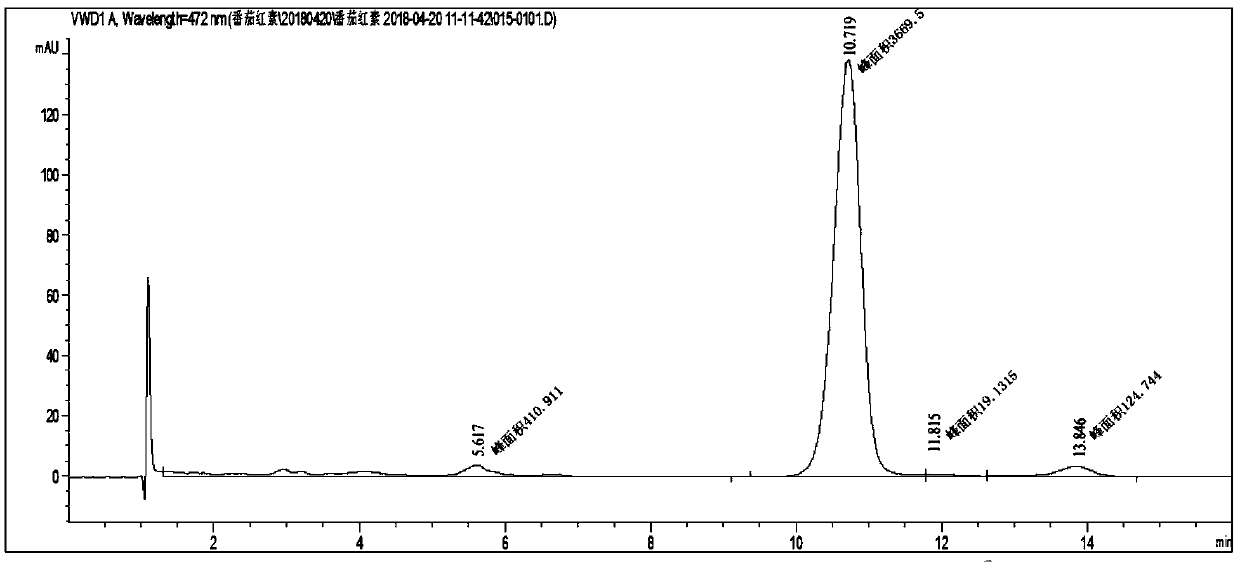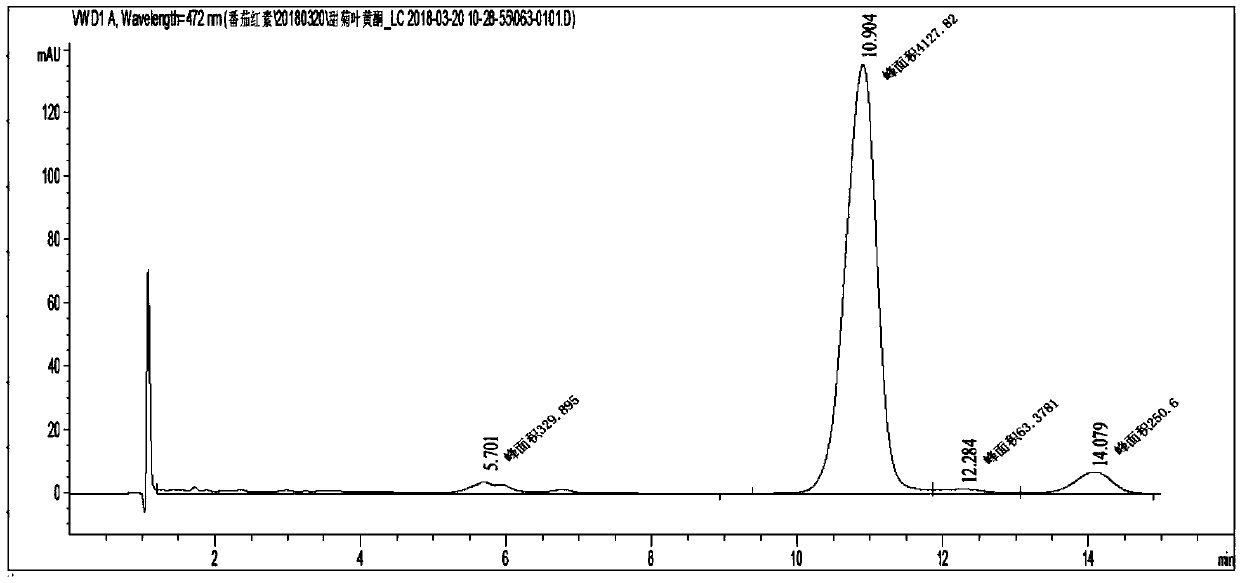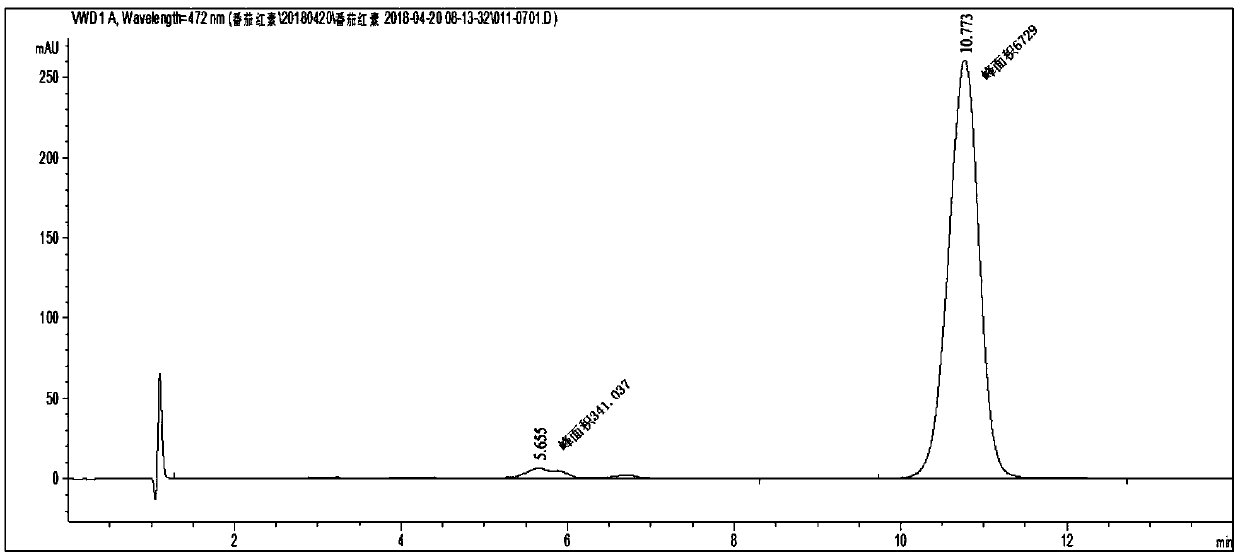Method for detecting the content of lycopene
A technology of lycopene and detection method, applied in the field of food detection, can solve the problems of error in detection results, trade disputes, and difficulty in controlling stability, and achieve the effects of ensuring accuracy and stability, simple and fast operation, and obvious technological progress.
- Summary
- Abstract
- Description
- Claims
- Application Information
AI Technical Summary
Problems solved by technology
Method used
Image
Examples
Embodiment 1
[0054] Embodiment 1: The detection method of the lycopene content adopts the following specific techniques.
[0055] (1) Weigh 5.05 g of tomato powder sample and place it in a 250 mL Erlenmeyer flask, add 100 mL of dichloromethane solution containing 0.05% BHT. Place in an ultrasonic cleaner for extraction, the ultrasonic power is 400W, the ultrasonic frequency is 40KHZ, the ultrasonic temperature is 40°C, and the ultrasonic time is 30min. After ultrasonic extraction, filter with qualitative filter paper to obtain test solution A.
[0056] (2) Pipette 2mL of solution from test solution A into a 100mL volumetric flask, add 10mL of absolute ethanol, dilute to volume with petroleum ether, mix well, and record it as test solution B. Put the test solution B in a 1cm cuvette, use petroleum ether as a blank, and measure the absorbance at 472nm to be 0.325. Bring A=0.325, K=5000 and m=5.05 into the above calculation formula (I) to obtain the total carotenoid content X in the tomato ...
Embodiment 2
[0059] Embodiment 2: The detection method of the lycopene content adopts the following specific techniques.
[0060] Except step (1), other technological process is with embodiment 1.
[0061] Step (1) is: take the tomato powder sample, add 0.05% BHT in dichloromethane solution, the ratio of solid to liquid is 1:5 (m / v). Place in an ultrasonic cleaner for extraction, the ultrasonic power is 300W, the ultrasonic frequency is 40KHZ, the ultrasonic temperature is 25°C, and the ultrasonic time is 60min. After ultrasonic extraction, filter with qualitative filter paper to obtain test solution A.
[0062] Test results: A=0.425, K=5000 and m=8.08, calculated to get X 0 It is 0.0762%; the peak area normalized ratio P=83.33%; the calculated lycopene content X is 0.0635%.
Embodiment 3
[0063] Embodiment 3: The detection method of the lycopene content adopts the following specific techniques.
[0064] Except step (1), other technological process is with embodiment 1.
[0065] Step (1) is: take the tomato powder sample, add 0.05% BHT in dichloromethane solution, the ratio of solid to liquid is 1:20 (m / v). Place in an ultrasonic cleaner for extraction, the ultrasonic power is 200W, the ultrasonic frequency is 40KHZ, the ultrasonic temperature is 50°C, and the ultrasonic time is 20min. After ultrasonic extraction, filter with qualitative filter paper to obtain test solution A.
[0066] Test results: A=0.3250.418, K=5000 and m=10.38, calculated to get X 0 is 0.0584%; the peak area normalized ratio P=86.28%; the calculated lycopene content X is 0.0504%.
PUM
| Property | Measurement | Unit |
|---|---|---|
| wavelength | aaaaa | aaaaa |
| absorbance | aaaaa | aaaaa |
| absorbance | aaaaa | aaaaa |
Abstract
Description
Claims
Application Information
 Login to View More
Login to View More - R&D
- Intellectual Property
- Life Sciences
- Materials
- Tech Scout
- Unparalleled Data Quality
- Higher Quality Content
- 60% Fewer Hallucinations
Browse by: Latest US Patents, China's latest patents, Technical Efficacy Thesaurus, Application Domain, Technology Topic, Popular Technical Reports.
© 2025 PatSnap. All rights reserved.Legal|Privacy policy|Modern Slavery Act Transparency Statement|Sitemap|About US| Contact US: help@patsnap.com



